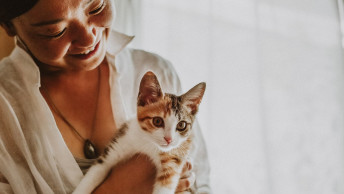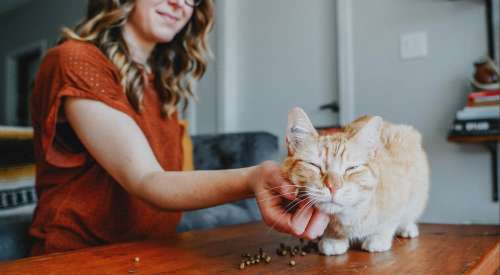January 8, 2021
Which Plants Are Poisonous to Cats?

Adding plants and flowers to your home is a great way to decorate and brighten up your space. However, many cat parents keep common plants throughout the house without knowing how deadly they can be for their feline friends.
Whether it's mushrooms that sprout in your garden or a favourite houseplant, it's important to know which plants are poisonous for cats. In this guide, we'll give you the breakdown of which plants to avoid to keep your furry friends safe and healthy.
Common Mushrooms Poisonous to Cats
Fall is when people know how to correctly identify mushrooms and take advantage of the tasty treats that nature has to offer. However, many pets also find mushrooms to be a tasty treat too. Often, this makes them very ill, and although it may seem like just an upset tummy at first, later can result in being deadly.
All it took was a tiny amount eaten (about 3 grams) to kill my precious furry best friend. Toxic Amanita Mushrooms attack the body by damaging certain proteins in the liver and kidney, leading to coma and, often, death. Death Cap Mushrooms are an invasive species that can be found all over North America. Keep your eyes peeled for these!
Tip: When it comes to mushrooms, it's best to clear your yard of them entirely, regardless of variety, to make sure no heartbreaking accidents occur.
Here are the most common toxic mushrooms your cat needs to avoid at all costs:
Fly Agaric (Amanita Muscaria); is the classic toadstool of fairy tales and legends. Don't let its colorful appearance fool you, though. These mushrooms have bright red caps with white spots and are known for their toxicity and hallucinogenic properties.
Jewelled Death Cap (Amanita Gemmata); is the cousin to the Death Cap Mushroom. It has a yellowish cap with white spots or 'warts.' It can be deadly and is often misidentified.
Elf's saddle (Helvella Lacunosa); has a grey 'saddle' and a lighter colored stem and can often be found in wooded areas. Not much is known about this mushroom, and reports of its toxicity vary, but this one should definitely be avoided.
Autumn Galerina (Galerina Marginata); These are brown mushrooms that like to grow on lawns or decaying wood. They will often pop up after a heavy rain, even in sawdust. These mushrooms are as deadly as the Death Cap, so stay away!
If you suspect your cat may have eaten a toxic or poisonous mushroom, make sure you take the mushroom with you when you take your pet to the vet. This way, the veterinarian can correctly identify what type of toxin or poison they're dealing with.
Symptoms of Mushroom Poisoning can include:
- Vomiting
- Diarrhea
- Abdominal Pain
- Weakness
- Lethargy
- Yellowing of the skin (jaundice)
- Uncoordinated movements
- Excessive drooling (ptyalism)
- Seizures
- Coma
Common Plants Poisonous to Cats
Besides keeping your cat away from mushrooms in the fall, there are many other everyday plants that your cat will also need to watch out for!
Some common poisonous plants include:
Autumn Crocus
Also known as Meadow Saffron, this purple flower looks beautiful on the outside, but is toxic on the inside. When ingested by cats, common symptoms include vomiting, diarrhea, and even kidney damage.
Azaleas
Watch out for these pink flowers. The vibrant azaleas are very popular among gardeners, but are deadly for our furry friends. When nibbled on, the toxins can lead to seizures, and can affect the brain and heart muscle.
Eucalyptus
Eucalyptus is a favoured plant among many people due to its healing properties. However, many fail to realize just how poisonous it is for cats. These oils aren’t good for our cat's tummies and because of this, results in severe illness, and even death.
Lily of the Valley
A common plant with a sweet smell, the Lily of the Valley flower sprouts in the summer with little white bulbs. However, be cautious! The bulbs themselves contain deadly toxins which can lead to death just a few hours after consumption.
Tulips
Who would’ve thought beautiful tulips could cause so much harm? Like Lily of the Valley, tulip’s bulbs contain a high amount of toxins. Symptoms of your cat ingesting tulips can result in diarrhea, depression, and rapid heart rate.
A few others poisonous plants include:
Cyclamen
Kalanchoe
Lilies (true lilies like Tiger, Day, Asiatic, Easter and Japanese Show Lilies)
Oleander
Daffodils
Hyacinths
Sago Palm
Poinsettias
These plants have varying degrees and types of toxins, but regardless are cause for concern should your cat decide to nibble.
Remember, immediate veterinary attention is crucial! Don't let your beloved furry friend be a victim. Clear your yard of all mushrooms, and be careful what kind of plants you keep in your garden and your house.
Every pet parent must be aware of the most common poisonous plants for their cats. We want to ensure you're well prepared and have the proper knowledge you need to help keep your furry friend safe, healthy and happy!
References: How to Identify a Death Cap Mushroom



